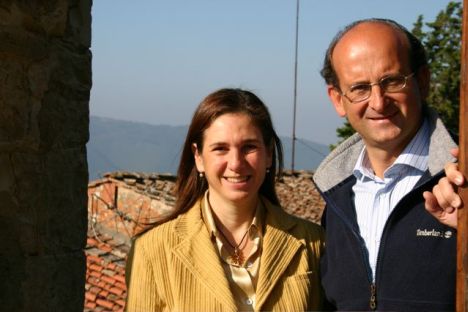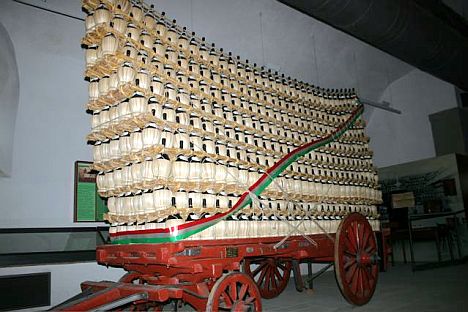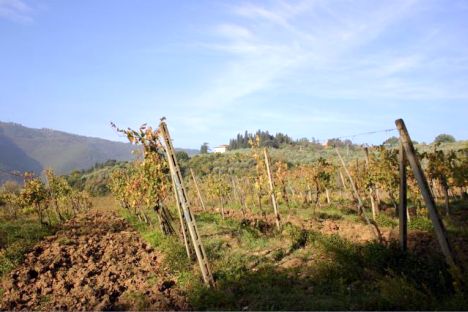Like the Colli Fiorentini, Carmignano or the northern hills of Chianti Classico, the Rùfina was firmly in the hands of wealthy citizens and nobles of Florence. There they owned their villas, castles and fattorias, where they went hunting and took refuge from the urban heat in summer.
The stewards of the estates saw to it that they themselves did not miss out. Those who owned estates in those days had only rights, but no duties. The mezzadria - half-lease - was there to provide the owner with plenty of wine, olive oil, grain and meat, without him having to worry about anything. With the decline of these feudal conditions in the 60s and 70s, the owners, lawyers, merchants, bankers, professors, nobles, suddenly found themselves forced to become agricultural entrepreneurs: Not only income had to be booked since the farmers no longer worked for free, suddenly massive costs arose.
 |
| The hamlet of Frascole near Dicomano |
One overstrained landowner after the other knew no other way to help himself in the face of the capital-eating costs than to get rid of his estates as quickly as possible. In the 70's, the big change of hands took place especially in the Chianti Classico. Often, the central core of the former large estate remained to the old owners. In order to keep the villa, the farmhouses around it - Poderi - were sold off, one after the other. No baron or marchese got away scot-free. Except the Frescobaldi.
The Frescobaldi dynasty, too, risked opening the final chapter of its 700-year history as a large landowner. While most owners hung their arms helplessly, however, the young Vittorio Frescobaldi realized in time that he would have to get ahead of the social revolution if he didn't want to be overrun by it. If he wanted to absorb the costs, he had to sell his products, especially wine, as profitably as possible. The Frescobaldi were lucky to have the right man at the helm at the right moment. Vittorio, the president of the family business, possessed something that most of the big landowners of that time lacked: the gift of entrepreneurial thinking. While his neighbors' estates went wild or changed hands, he dusted off the late medieval structures of the Marchesi de' Frescobaldi and facilitated a successful transition to the modern market economy.
 |
| Tiziana and Lamberto Frescobaldi. She looks after communications% Lamberto looks after technology in the family group. |
Where the Frescobaldi 's have their most beautiful property - the Nipozzano Castle in the Rùfina - time seems to have stood still all around. The sale of the agricultural properties has never taken place. With two or three exceptions, the owners have remained local.
Global and local players
Frescobaldi is the largest producer in the area, with almost 50 percent of Rùfina production marketed under the Nipozzano brand. If Frescobaldi were characteristic for Rùfina, the appellation would have to be called "modern".
Despite the strong economic presence of the family business, however, it seems to represent more of an enclave in this wine region, which is reminiscent of Chianti Classico 20 years ago. Although the Frescobaldi emphasize to stand by the Rùfina appellation and Ferdinando Frescobaldi presided over the consortium for twelve years, a wine-cultural generation lies between the noble wine entrepreneurs and the other half of the appellation. In a positive as well as in a negative sense. 20 million Frescobaldi bottles marketed in a tailor-made international style from half a dozen wineries spread all over Tuscany do not fit at all to the rural reality of the Rùfina
Although Rùfina is undisputedly one of the growing areas with the best climatic conditions in Tuscany, it remained practically unnoticed. The Tuscany boom of the 90s passed Rùfina by unnoticed. As many as two dozen producers bottle Chianti Rùfina DOCG, four of which are trading houses and one Cantina Sociale. Among the almost 20 self-marketers there are old noble families, which can look back on family trees as far as in the deep Middle Ages, picture book wineries, which are dressed up with non-agricultural income, some larger, economically independent fattorias with 100,000 to 200,000 bottles, and small producers with 15,000 to 50,000 bottles, which are only able to make ends meet thanks to massive self-exploitation.
Only the renting out of vacation homes and - if the debts become too threatening - the sale of properties really bring money into the farm's coffers.
The wine of the Rùfina is undervalued: For despite the excellent growing conditions for Sangiovese, bottle prices are low and do not stand out noticeably from those of regular Chianti. Not only for the grapes, but also for the olives, the conditions here are particularly good: Rùfina olive oil is among the best in Tuscany. Most farms have thousands of olive trees and the cooperative oil mill in Pelago works according to the most modern quality standards. Only: There is no money to be made with olive oil today, not even if it is above average.
Centre of the Italian wine world
At the end of the 19th century, Pontassieve - gateway to the Rùfina and bridge town at the confluence of the Sieve and the Arno - suddenly gained importance as a railway junction. At that time the railway line to Rome followed the Arno and passed by Pontassieve. First the line coming from Florence to Arezzo was completed, later the one to Borgo San Lorenzo was added.
The favourable transport conditions attracted industry and commerce: A railway workshop was built, glass factories and cement works. The wine trade also flourished, and wineries soon lined up along the railway line. In the post-war years, there are said to have been about 50 wine houses in the area. Pontassieve was a trading centre for wine from all regions. Not Siena, Florence or even Montalcino were the centers of wine in those days, but Pontas-sieve. It was also Pontassieve that supplied Florence with wine. With the "carro matto", the crazy wagon, the "Fiaschi" were driven to the city 20 kilometres away. One of these crazy wagons is in the wine museum of Poggio Reale in Rùfina: 2800 Fiaschi at 2.5 liters, which is still seven thousand liters of wine, were driven to Florence per trip in an extremely risky way.
The Fiasco, the bulbous, straw-wrapped glass bottle, was first produced industrially in Pontassieve in 1877. Until then, these bottles were blown by mouth, were quite fragile and the wine had to be protected from oxidation with a layer of oil. Therefore, a fiasco was developed to withstand the pressure of the cork. From that moment on, the export of Chianti and all wine that left the country under this name was decisively simplified. In the 1970s and 1980s, the fiasco, which had been in use as a wine vessel since the 15th century, increasingly became a symbol of poor quality.
 |
| The Fiasco - epitome of bad quality |
But the Rùfina was not only a hub for the trade of wines from all over Italy. On the slopes of the Arno and Sieve valleys up to Pomino, viticulture has always taken place, documented since the 15th century. A document from 1921 proves that 2.6 million liters of wine were produced in the Rùfina area at that time, which coincidentally is about the same amount as today's Chianti Rùfina DOCG. As early as 200 years before, an actual appellation was created for the wine of this area: Together with Chianti, Val d'Arno di Sopra and Carmignano, the appellation "Pomino" was protected by the Bando of the Grand Duke Cosimo III de' Medici of 24 September 1716 and the boundaries of the production area were defined. By "Pomino" was meant not only the current, very small Pomino growing area, but the DOC areas of Pomino and Rùfina together. Thus, already 300 years ago, the Rùfina was distinguished as a "terroir" for wines of special quality.
At the time of the Medici, a lot of white wine was drunk. That is why in Tuscany mainly Trebbiano and Malvasia were produced. Only a few wine regions, especially Chianti Classico, Carmignano and Pomino-Rùfina, produced appreciated red wines at that time. Rùfina wines always had the reputation of being particularly structured and durable and were on a par with the wines of Gaiole, Radda and Castellina. Rùfina would have had a successful career as a terroir for top wines if things had been different in the 1970s and early 1980s. Those were the times of the wine boom, and the bottlers had a great demand for wine.
Land users took the opportunity to convert their mixed farming, where olive trees and vines still stood side by side, to mass production. Vineyards that could be tractored were planted with fertile clones. It was not character that was required, but quantity. This went well until the methanol scandal in 1986, when the boom turned into a crisis in one fell swoop. Rùfina has not fully recovered from this economic setback to this day. For the crisis deprived the farmers of everything that could have brought them an income. The fact that the situation is still tight today is visible everywhere where the owners live mainly on income from agriculture, that is: from winegrowing. Still only a part of the former mass plantations has been replaced by denser plantations with better clones.
 |
| Machine-raised vineyard - the soil is freshly tilled |
A massive upswing in quality has nevertheless been achieved in the last ten years, but only because yields are kept uneconomically low. A winegrower is not allowed to produce more than 4000 to 6000 kilos of grapes per hectare - depending on the condition of the vineyard - in the old facilities, if he does not want to reckon with quality losses. Lorenzo Mariani (I Veroni): "At the moment, our goal is not to earn money with the wine but not to lose too much. We have newly planted our 15 hectares and renewed the cellars. These are investments that were unavoidable but weigh heavily. If we've been seeing a significant improvement in Rùfina wines for a few years now, despite the difficult situation, the generational change is responsible for that."
Click here for thesecond part
Click here forthe third part
The above article was kindly provided to us by the Merum editorial team. Many thanks for this. If you would like to order a subscription to Merum, you can do so here
Order Merum subscription
All photos © Merum